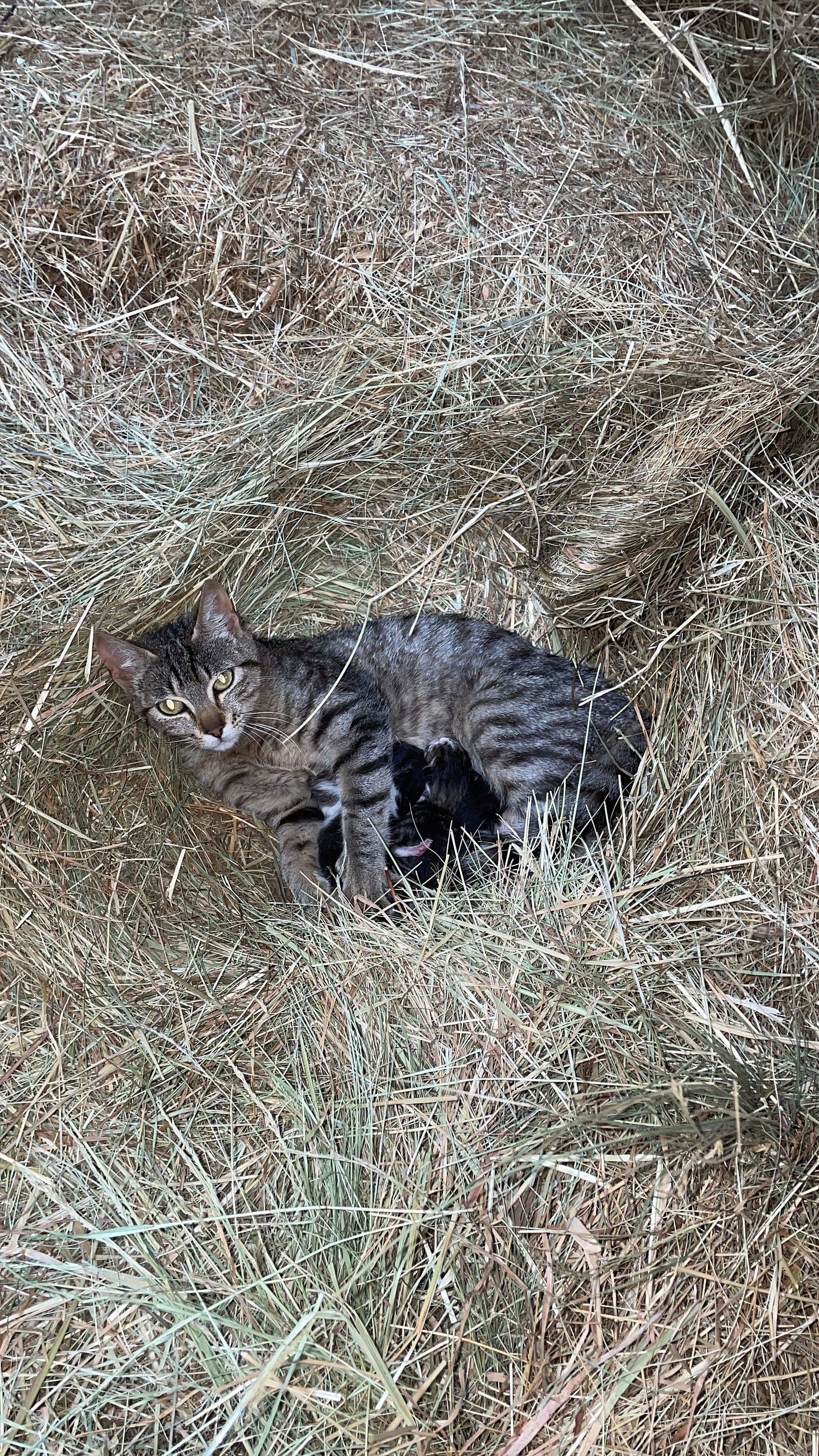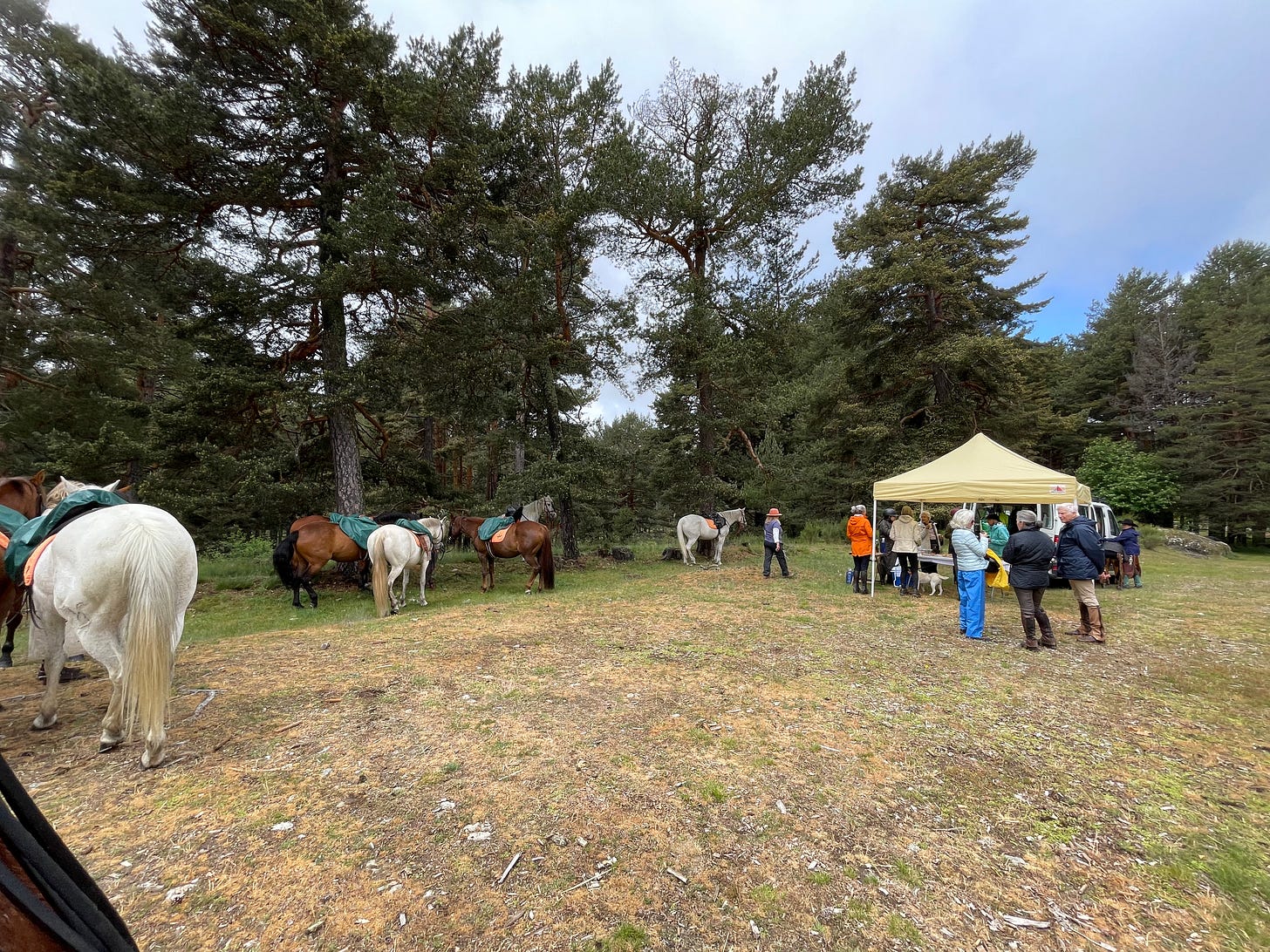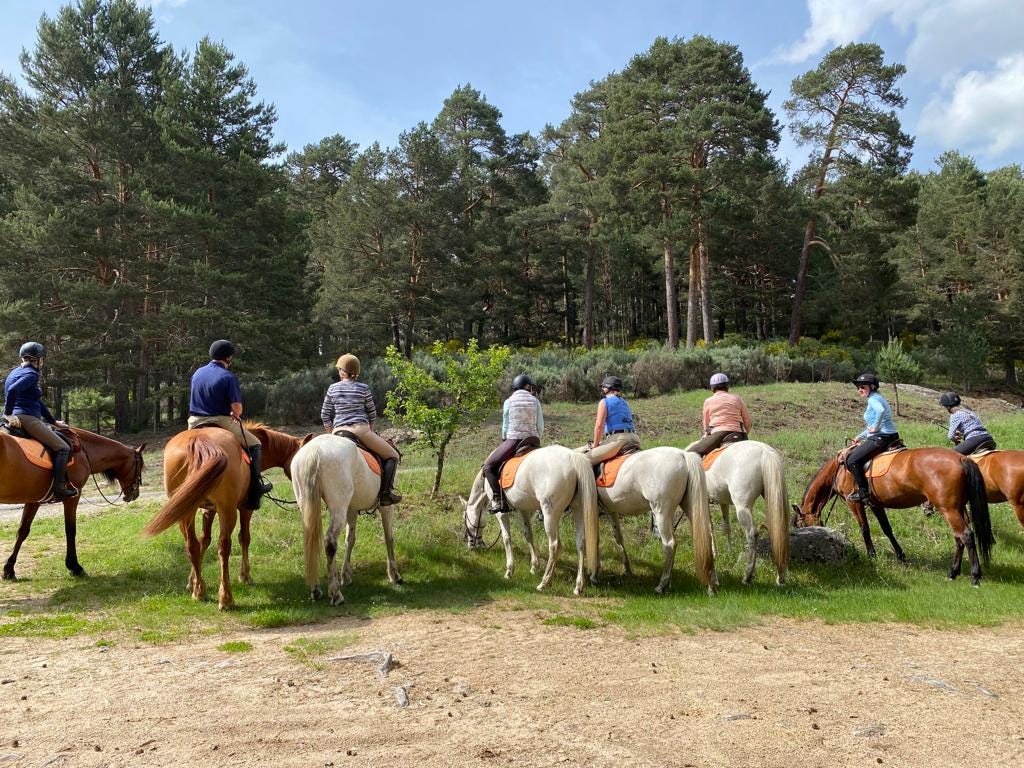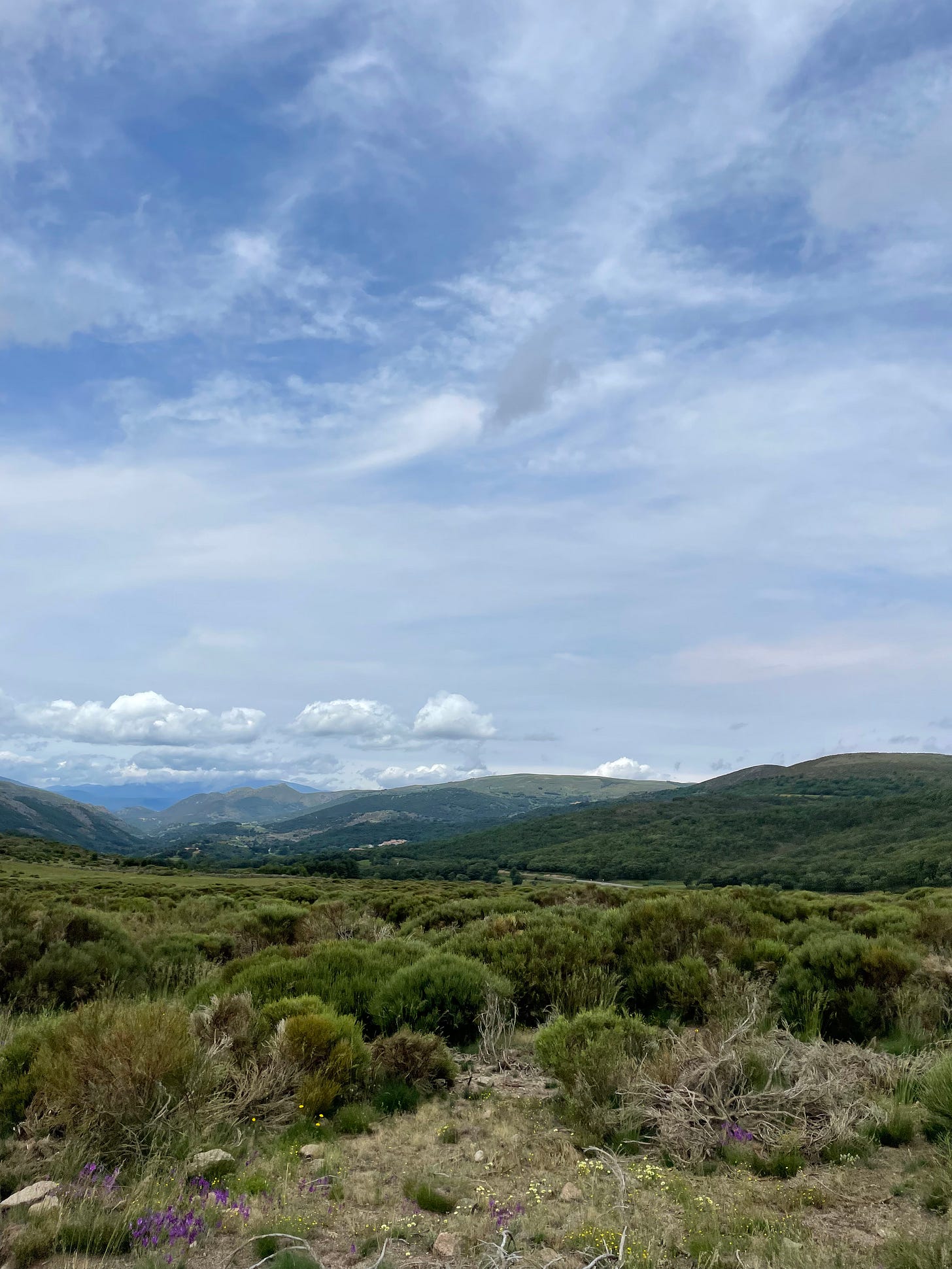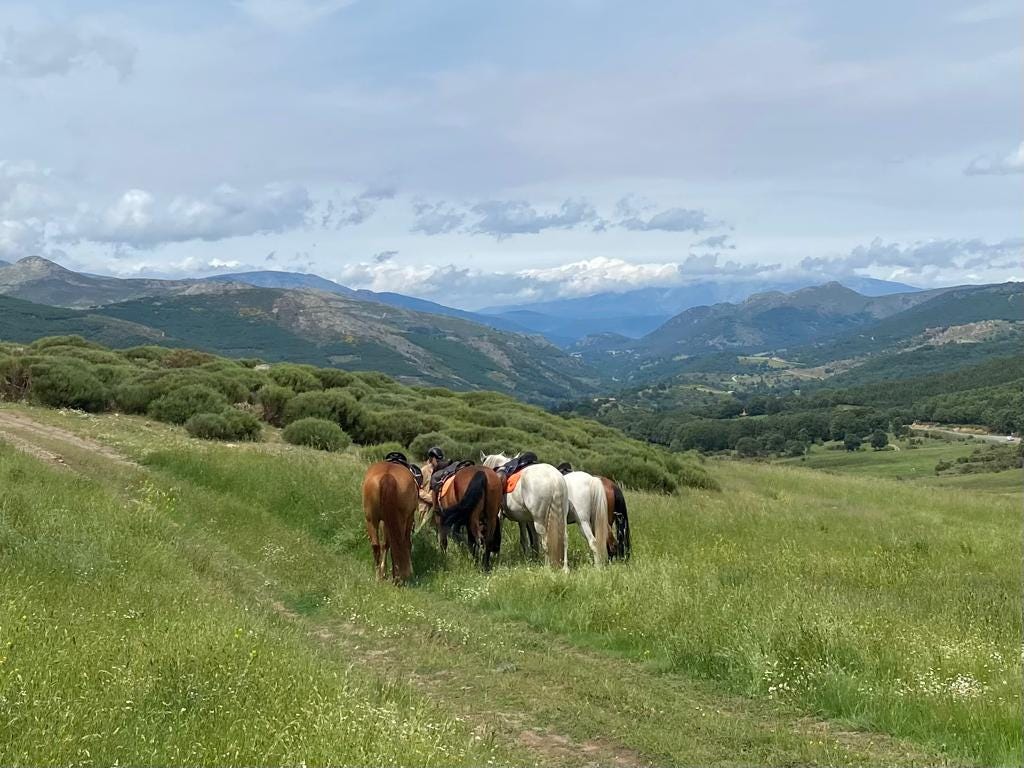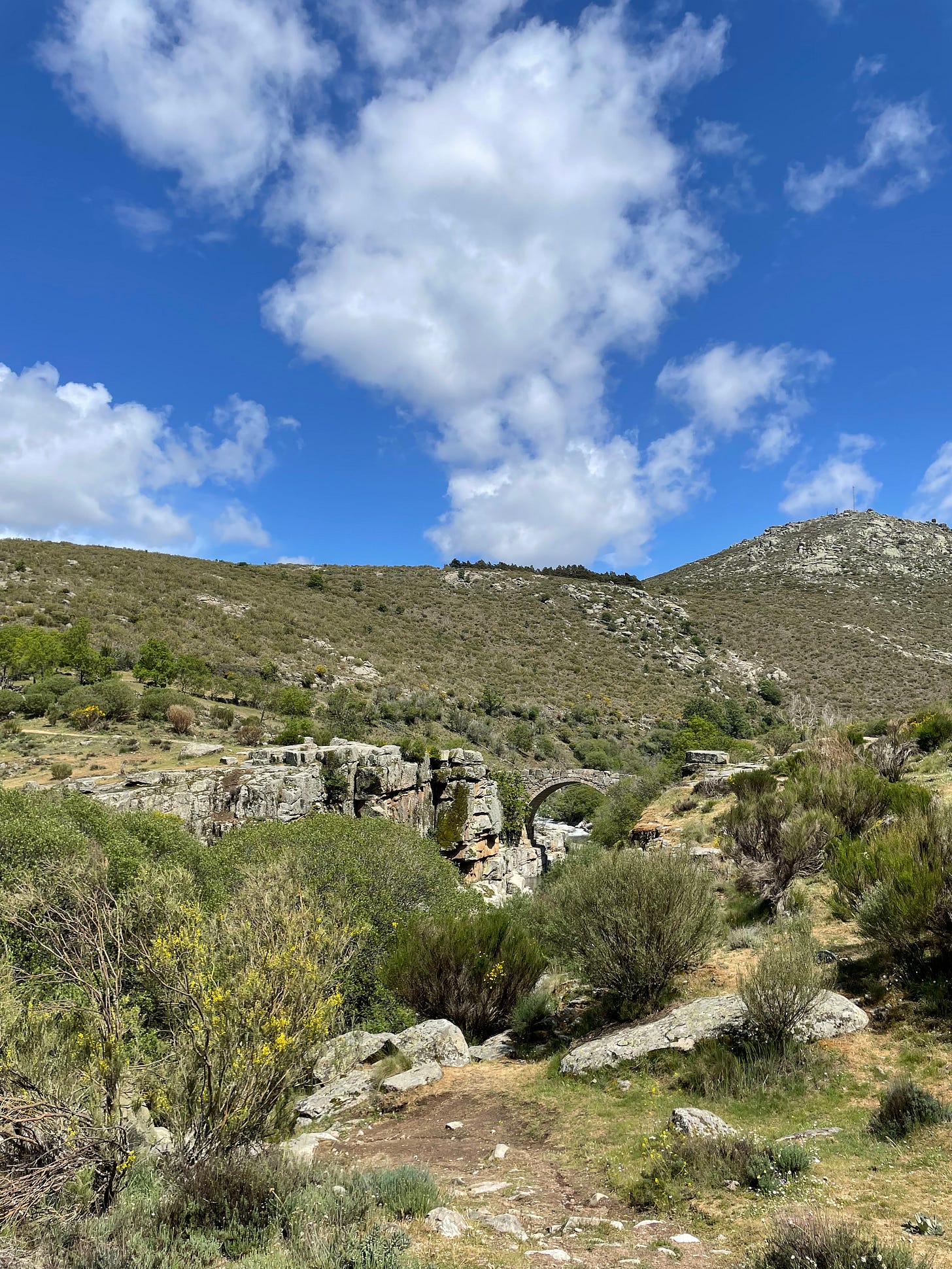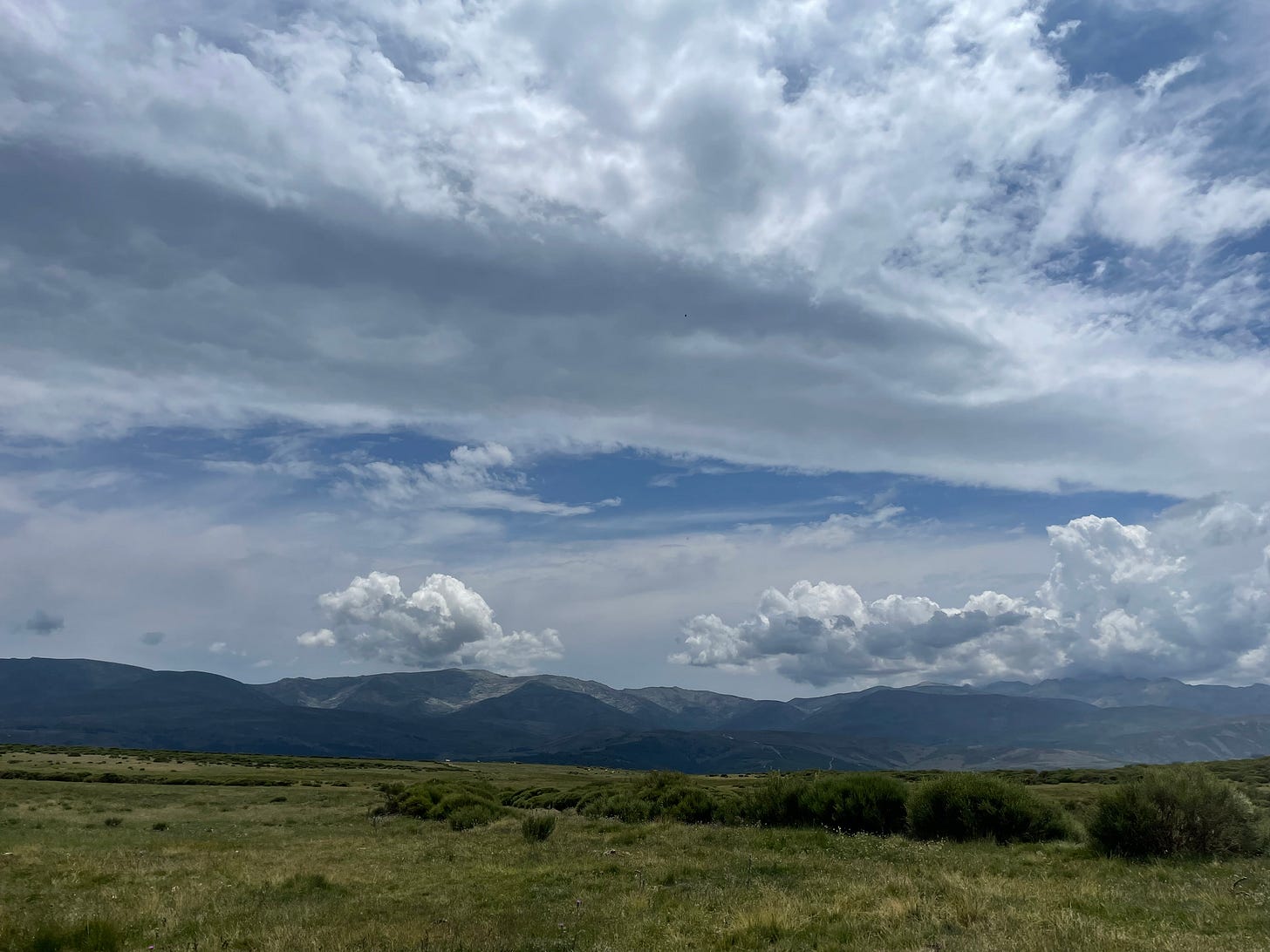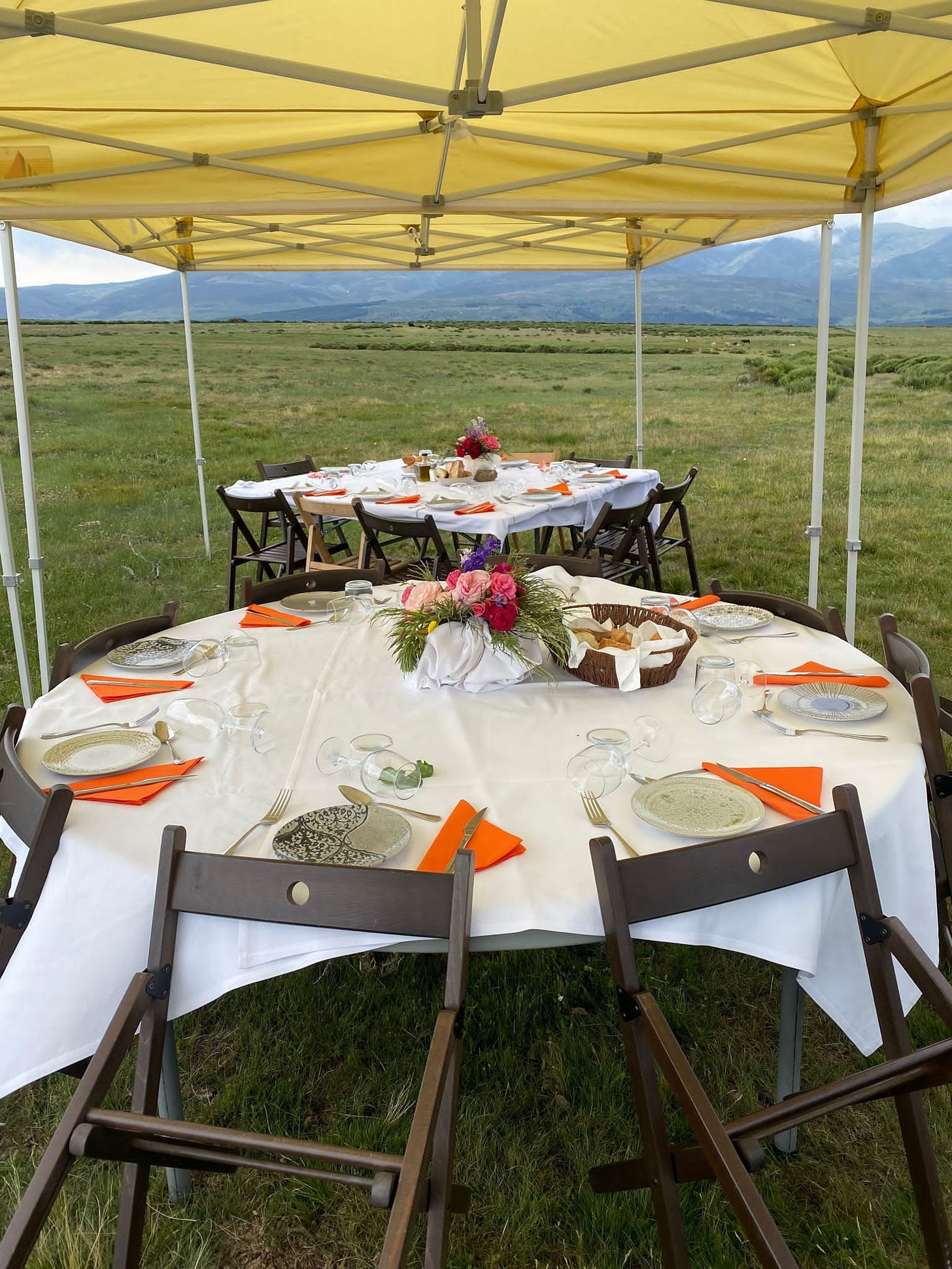Last Sunday, we welcomed a new group to Navarredonda de Gredos, the town Equiberia is based out of. My colleagues and I spent the day, washing, cleaning, and polishing both horses and tack in anticipation of their arrival. I am also happy to announce that one of our barn cats had kittens the day prior! They are very cute and she is already demonstrating her talent as a cat mom.
The vans that we use to transport both clients and food also were in need of a good vacuum and scrub, so that was taken care of before we met the clients as the Parador de Gredos, a hunting lodge established by Alfonso XIII turned hotel (it’s gorgeous — highly recommend). We had a quick toast, where each client was given some time to talk about their riding background so we can pair them accordingly with the right mounts. María Elena always says that a proper pairing is about personality-matching just as much as it is about riding ability, so we try to get to know clients before we put them on horses. The clients were amazing! Such a great group of horse people. Unsurprisingly, about three of them had been up in Cheshire Country (my home) in March for the Vixen Hunt, and one of them knew my mother personally. The horse world is, and always has been, incredibly small.
My co-worker and I headed home after that, as we knew we had a very early morning ahead of us.
The following morning, we left for the barn (la cuadra) at 8:30 am. I’m sure that sounds quite late to American equestrians who are accustomed to arriving at the barn around 6 am or 7, but trust me — 8:30 am is early here. Pretty nice, right? Until you adjust to the schedule and 8:30 am feels early for you.
Once we arrived at the barn and after we were greeted enthusiastically by Equiberia’s three enormous mastiffs, Gordo, Cartucio, and Bola, we went about doing normal barn chores: setting grain, opening up the place, preparing to bring the horses in from the Nava. Quick side note: the Nava is a field that is part of what the Spanish call Common Land, meaning anyone can pay a minimal fee to keep any kind of livestock in that field for the year. So there are cows, sheep, horses, and an occasional goat or donkey coexisting in one field. It’s pretty cool.
The way we bring the horses in from the Nava is slightly unconventional, at least to an ex-equitation/4Her/foxhunter/showjumper/etc American. I’ll let the video speak for itself.
The horses go right into stalls (they do not have specified stalls, which tripped me up a bit when I was trying to learn their names and identifying features — we have a lot of greys) and they chow down on their breakfast. We often have a confused stray horse or two who has not realized that there is an open stall a little further down the aisle, but we always help them out.
While they’re eating — to be time efficient — we began our process of grooming: one person tackles the bodies; one person, the manes and tails; and one person, the hooves. This week, our first group consisted of ten clients (plus María Elena, Joe, and myself/the other working student), so we were getting thirteen horses ready. The horses are great sports — especially the older ones, no surprise there — and are tolerant of us working with them while they’re loose in their stalls. My favorite mare, Mara, can be a bit dramatic, so she’s often relegated to a tied up, stationary position.
After we finished grooming, we saddled up. At Equiberia, the saddle pads, girths, and breast plates are stored attached to the saddle to maximize our efficiency. The weather is much cooler (and so much less humid) than east coast US summers, so the horses are not sweating as much which allows us to reuse equipment between washes. At this point, we were way ahead of schedule: it was 9:30 and the clients were arriving at 10:30 am. But when working with horses, being ahead of schedule is much preferred. I learned that as an equitation kid: I was happy being an hour early to a class if it meant I wasn’t late. We took our time painting feet (grasa de cascos), fly spraying, and applying fly gel (which I haven’t seen before, but it’s quite effective) before bridling around 10:15 am.
Again, the horses here are incredibly well behaved; we leave them in the stalls bridled. I can think of maybe one horse I’d be confident enough to do that with at home, let alone thirteen. While the horses waited patiently for the clients to arrive, we frantically reapplied sunscreen after slipping out of our grooming jackets. We had just enough time to take a deep breath and rehydrate before the clients arrived, wandering the barn aisle, wondering which horse they’d be riding. María Elena paired everyone up and gave each person a rundown on their horse, how they behave, and what they like out of a rider. After that, each client grabbed their horse and headed to the ring to get on. I wasn’t riding that morning, so I helped the clients get on. That means tightening girths (which, thanks to a lifetime of horses that love to bloat, I am quite good at), adjusting stirrup lengths, and holding horses so folks could get on. Once we had everyone on, María Elena and the other working student brought their horses out to mount up.
They headed out, a chorus of goodbyes filtering out behind them, as we prepared the van for aperitivos. At Equiberia, each day of a particular route is broken up by, essentially, when the riders will be fed. They are served aperitivos about an hour and a half to two hours into a ride, where they meet those of us in the van at a marked location and are plied with local food, beer/sherry, and most importantly, water. Each rider is given a water bottle in their saddle bag, but rehydrating on the ground is a different type of satisfying. Once we loaded up all the food, tables, drinks, and tents, we headed out to the meeting spot. While it takes riders quite a while to reach that point, it takes us about ten minutes to get there by vehicle.
Two of us set up the tent and tables (one for food and one for hand washing) while the other prepared the food. If you’re wondering what kind of food the clients are fed at aperitivo, I’ll tell you. Think of cheese sourced and made down the road. Think of jamón from your backyard (apologies to my fellow vegetarians — that’s only a pleasant image for some). Think of soft-on-the-inside, crunch-on-the-outside bread baked that morning. Think of fresh tomatoes that require nothing more than olive oil, pepper, and salt to become a fine dish. That’s what the clients came upon when they rounded the bend at the end of their first stretch of ride. After they dismounted, team members took the horses to hold them while the clients ate. We usually try to split up the “pullers,” or the ones who would rather eat than rest. I was very lucky and had Bonita as my puller, who is not too bad, just very insistent about eating where she wants. The others took quick naps, thank goodness.
After the guests had their fill, I helped some of them get on before getting on myself. The other working student and myself were riding Bodeguero that day, a nine year old gelding who is quite lovely to ride. He reminds me of a children’s hunter (both show hunter and foxhunter are applicable when it comes to Bodeguero). He had had a number of client riders over the past few months, so María Elena wanted us to remind him what it’s like being a staff horse. That means allowing his rider to get off and on from the ground to open and close certain gates, opening and close gates with his rider mounted, turning around when the group is headed another direction, etc.
We left, and I assumed my position as sweep rider i.e. the last rider in the group. This position is helpful because I can see what’s happening with the other riders in front of me and if there are any issues at all. It was also great to chat with some of the clients and get to know them — that’s definitely a wonderful part of the job. I was also super excited because I knew that we were headed towards an amazing lunch at Cesário’s bar. I went there with my first group of clients three weeks prior, and it was a great experience. To get there, we passed through some of the most scenic parts of Gredos’s valleys. The mountains never fail to impress me, and they didn’t this ride.
Once we arrived at Cesário’s, we dismounted and tied our horses to trees close to the branch of the Tormes River that runs beside the restaurant. They usually settle in pretty quickly after they’re tied — riding fourteen miles is exhausting! Once the horses were secure and we loosened our girths, we headed up for a drink and some delicious paella.
We took our time at lunch, eating fresh salad, bread, goat’s cheese, and seafood/chicken paella prepared in a huge pan by Cesário himself. He doesn’t understand why I don’t eat meat, but he kindly constructs my plate without any anyway. We finished eating around 3:15, and María Elena decided we would head out around 4 pm, which left ample room for a nice siesta for the clients. The other working student and I took advantage of the sleepy clients and began quietly putting bridles back on horses — it’s easier to do it without lots of eyes on us! Once all the horses were rebridled, we notified the clients that the horses were ready for them and they happily strode down to retrieve their now well-rested beasts. One of the clients hadn’t gotten along with her horse very well, so she and I switched, and now I was riding the wonderful mare, Bruja. Don’t mind her name. She’s only witchy to other horses, not humans.
We had about a forty minute ride back to the stables after that. The horses were quite excited to get home, as horses are apt to be. Once we arrived, we striped the saddles and hosed the horses down before feeding them dinner, which the other team members had already put in stalls. Once they finished eating, and the clients drank some water, we walked the horses out to the Nava and finished up for the night (checking on the kittens and feeding the dogs).
The following day, we embarked from the barn and headed out in the direction of Navacepeda, a neighboring town to Navarredonda. On this day, I was riding Mayo, one of our more sporty horses: he’s built like a small, grey thoroughbred. The ride was beautiful, and I was excited to be back riding with the clients. It’s so fun getting to know people; we spoke about books, TV shows (one was a huge Game of Thrones fan, so we spent a good amount of time sharing thoughts on the final season), and our lives in general. Apertitivos took place in this beautiful field that gave us a great view of the mountain range. The team took turns holding the many horses before we were off again, heading in the direction of my favorite restaurant (that I’ve been to thus far).
We arrived at Pozo de las Paredes around 2:30, 2:45ish. The restaurant is right on the Tormes. To reach it, we had to cross a gorgeous, arched medieval-aged bridge, which we can do on horseback. While the Tormes is beautiful in most locations, this is one of the best. And you can swim there!
After we crossed the bridge (and had our wonderful photo op) we tied the horses up and headed in for lunch. Not only do I love the view at the restaurant, but Hemingway spent time there! The English major in me is and was ecstatic. We ate a delicious lunch there with lots of wine before some of the clients headed out to swim. The team bridled up the horses, who were just waking up from their nap. We realized that one of the horses, Texas, lost a shoe, so we threw a boot on her before heading out.
We had some lovely canters parallel to the Tormes, passing a very cute fisherman’s hut on our way home. The ground became quite rocky as we were moving on from the river; by rocky I do not mean gravely. I mean rocky, with the horses scaling medium sized boulders buried in the ground. Lucky for us, they are very cognizant of where they place their feet, so there was very little slipping or sliding.
Once we got home, we did the same thing that we did the day before: baths, dinner, and out in the field. After a wonderful day, it was great to see the horses happy in their field, though those of us who had to groom the following morning were a bit disappointed to see all of the rolling in the Nava’s most dusty areas.
I was once again in the van on the final day of the ride, but I was quite okay with that. It meant I had more time to drink one of the most amazing views I’ve seen thus far in Gredos. After we arrived to the most picturesque spot on Cañada del Gallo, we set about unloading tables, chairs, tents, coolers, and other assorted dining-ware in preparation for lunch.
After we set up three of the large tables, the tents, and set the dining places for each person, we had time to relax a bit. I took the time to go set up halters in a wooded area for the riders to more easily tie their horses up once they arrived.
When they did arrive, I helped unbridle and halter some of the horses, inspecting their bodies and tack to make sure everything was alright after a significant ride. The clients migrated over to the tables and tents, either snagging a beer, a seat, or both. Lunch was eventually served after they all caught their breath, which was catered by El Milano Real’s chef, Javi. The food was, as always, amazing, and he cooked it right out of the back of his van. He started us with blended potatoes, paprika, and other assorted spices topped with bacon (none for me). For the main, everyone else had (from what I heard) great chicken, and I had some delicious white fish. After everyone was full, some of the clients took a bit of a siesta while we, the team, cleaned up and went to bridle the horses. It became quite clear to me on this ride that the horses are quite good at napping on cue! After their siestas (both the clients’ and the horses’), we sent them off on their way back to the stables as we finished deconstructing tents, tables, etc. We bid Javi goodbye and headed back to the stables, we were unloaded much of the van so we could clean it before the next round of clients arrived.
The horses (and clients!) arrived back on the farm shortly after, met with a wonderful greeting from the dogs and cats. The horses received their final baths for a bit before eating and heading out once again. The clients bid a tearful farewell to their horses (and the Equiberia team, I hope) for the day before heading out to Segovia, where they’ll continue their riding trip.
After we finished with the horses, we cleaned the thirteen bits (oof) and gathered the now very stinky saddle pads for washing before heading out. Three of us went to check on the foals, Torbellino and Montana, who are in a different field closer to town. We fed the two of them, who are both about seven months old, and worked on familiarizing them with extensive human touch. After we spent some time with the youngins, we all headed home for a quick beer and a shower!
We now have one week “off” before the next group of clients come. Despite that, we have much going on with the horses, cats, foals — you name it, so I look forward to updating you soon!
Thank you for reading.




